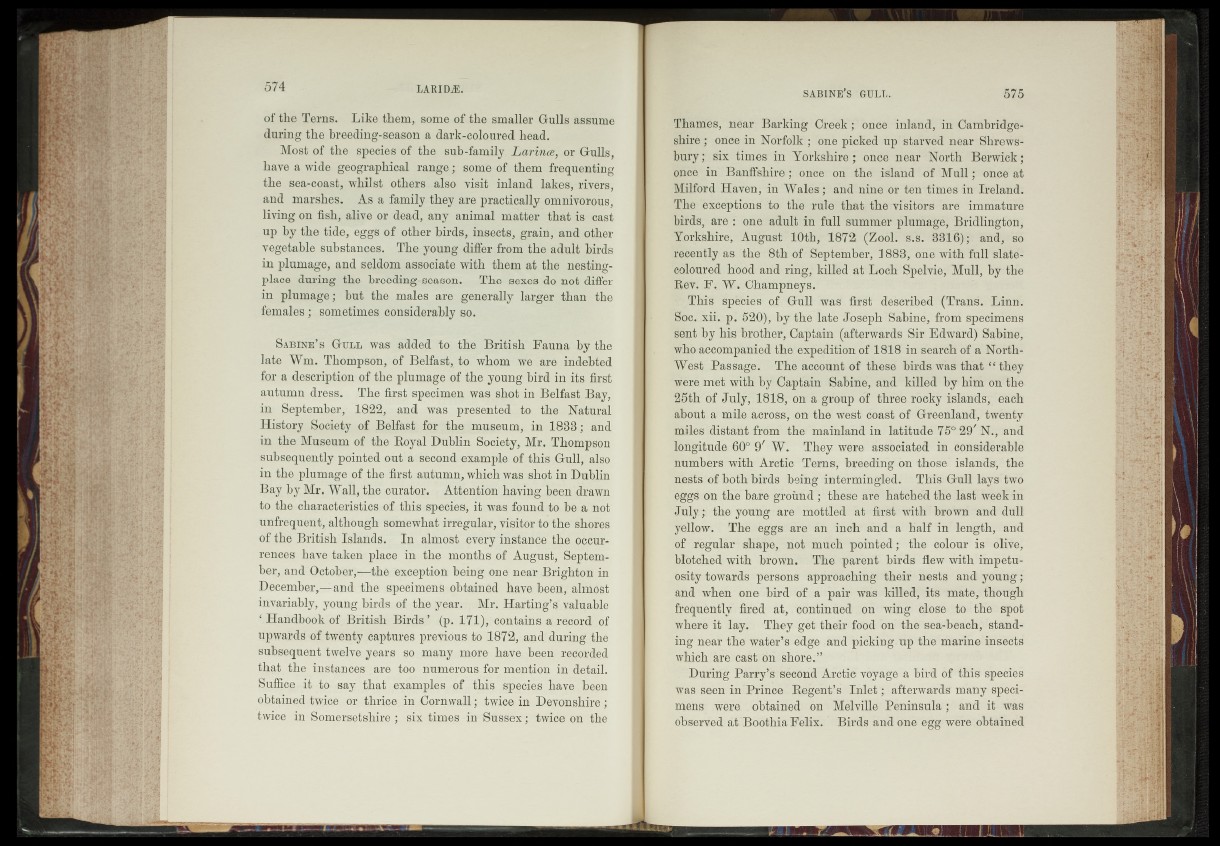
of the Terns. Like them, some of the smaller Gulls assume
during the breeding-season a dark-coloured head.
Most of the species of the sub-family, Larina, or Gulls,
have a wide geographical range; some of them frequenting
the sea-coast, whilst others, elso visit inland lakes,-rivers,
and marshes* As a, family they are practically- omnivorous,
living on fish, alive or dead, any animal matter that .is'east
up by the tide, eggs of other birds, insects, grain, and other
vegetable substances. The young differ from the adult birds
in plumage, and seldom associate with them at the nesting-
place during the breeding-season. The sexes do not differ
in plumage; but the males &x$ generally larger than the
females; sometimes considerably so.
Sabine’s Gull was added to the British Fauna by-the
late Wm. Thompson, of/Belfast, to whom'we are indebted
for a-description of the plumage, of the young/bird in its^first
autumn dress. ,Thp fipst specimen was shot in Belfast Bay,
in September,;. 1£|22, and^Vvas presented^ to. the Natural
History Society of Belfast for the . museum,v and
ip, the Museum of the Royal Dublin Society;, Mr. fl^mpson
subsequently-pointed out a, second example, of this?Gull;|^|so
in the plumage of the1 first autumn, which waji -~sbht ,iti Dn-blin
Bay by Mr. Wall,,the .curator, _ Attention haviri^3mx‘. drawn
to the characteristics of this species, it was, found to be a hot
unfrequent, although somewhat irregular, f iMteftij ther shores
of the British Islands. In almost e^eryunstancfef
rences have, taken place in the months^bf’/August, Seplem-
ber, and Octoberi^-dhC; 'exception. being on ear Brighton’ in
December,«-^and -the -spe&imen^btained have/|)ee^| almost
invariably, young,bird's of the year. 5/,?Mr. Harting’s/v^qable
‘.Handbook of British'.Birds/ 17.1,)^qtnfei®s-*a record of
upwards of twenty Captures pre^ippsvtb 1872,:aUd|during the
subsequent twelve:years- so many>Mpre, have begm. redeSded
th§,t. the instances „are too numerous.for meption in defail,
^ufijeg^it to say ;that-^xaniplesb'M* this .species lmyebf>e,en
obtaipeddwjce ~ or^ihri^|.an Gor n wall; twice- in.Devonshire;
twice in* Somersetshire ; ^ six -times -in Sussex / twice on the
Thames, near Barking1 Greek ;'once inland, in Cambridge-i
shire ;- once in Norfolk; one picked- up* starved near' Shrewsbury
; six times in Yorkshire f -ÖBels'-neaf vNorth Berwick;
öhc’é in Banffshireonce on the Mahd ’ of Mull; once'at
Milford Haven; in "Wales; and nine|èr fén times in Ireland.
The 'éxóéptions to the rule" that the visitors are- immatuff
birds, are • one adult in full summer plumage, Bridlington,
Yorkshire, August'''10th, 1872'- (Zool.' s.'s. 3816); and, so
recently as ’the-’-8 th of' September/If883, one with, full slated
floured hood and ring,' killed atrLoch ^Spelvie; Mull, by'the
Rev. F. W. Ghampheys/
/T h is Ipefeies- of Gull was first described (Trans. Linn.
’Soc., xii./pi ;520)‘,^y/the date Joseph-Sabine, from specimen^
lent by his'brother, Gaptai-n (afterwards Sir Edward) Sabine/
who accompanied the expedition of 1818 in search of a North-
West; J?assage., • Thé Account, of these bu;dswas that “ they
were met with byl Gaptaim 'Sabine, and kiffid by him oifWe-
P ith of Lulyf^lBlS, on a group of three rocky islands, each
äboutiar-mile across, on the west, coast of Greenland, twenty
miles "distant from th e "mainland in latitude 7 5Q'2'9/N:; and
longitudes60° 9' W. They were assbeiated ik.considerable
numbers with Aretie Terns, breeding on tboèél islands, the
n'ests of both birds hefeg intermingled*, This Gull layhtwh
Jig s on the hare ground / these are hatched the last week in
duly /-the: young-are mottled; at first with’’brown and dull
yellow. Thesiégg-gf arè an inch and a half inf length, and
pf regular shape, not much pointed; the colour is' 6ïxve£
blotched with brown.' The parent birds.flew with Impetuosity
towards ' persons approaching'their nests anA y@®»g ;
and when oneAxüéfrmf a pair was killed; its mate, 'though
Ifequêutlw fifed at, /eontinfed ,,on ’wing close, to the spot
where m lay. They get-their food' om/thersseä‘,-beach; stand-
?ffigJ neaï'the'wat'er’s edge and picking, up the marine insects
whieh are casfr'oh ashore *n
/ During Parry’s second1 Arctic voyage.'a bfrd óf this speèiêi
was seen in-Prince Z Rpgenti's-: Inlet; afterwards many specif
mens were . obtained on /MéMle>*<Penmsula ; and ii$ was
observed at/Boothia Felix. Birds and one egg- were obtained